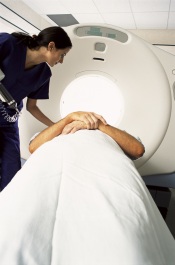Evaluation Procedures for Stroke
Evaluation Procedures for Stroke
How is stroke diagnosed?
Along with a complete medical history and physical exam, your doctor may do these tests.
Imaging tests of the brain
Computed tomography scan (also called a CT or CAT scan). This test uses a combination of X-rays and computer technology to make horizontal, or axial, images (often called slices) of the body. A CT scan shows detailed images of any part of the body, including the bones, muscles, fat, and organs. CT scans are used to detect abnormalities and help identify the location or type of stroke.
Magnetic resonance imaging (MRI). This test uses a combination of large magnets, radiofrequencies, and a computer to make detailed images of organs and structures within the body; an MRI uses magnetic fields to detect small changes in brain tissue that helps to locate and diagnose stroke.
Radionuclide angiography. A nuclear brain scan in which radioactive compounds are injected into a vein in the arm, and a machine (similar to a Geiger counter) creates a map showing their uptake into different parts of the head. The images show how the brain functions rather than its structure. This test, only done in special situations, can often detect areas of decreased blood flow and tissue damage.
Computed tomographic angiography (CTA). An X-ray image of the blood vessels. A CT angiogram uses CT technology to get images of blood vessels.
Magnetic resonance angiography (MRA). This test is used to evaluate blood flow through arteries in a noninvasive (the skin is not pierced) manner using MRI technology.
Conventional cerebral angiogram. A catheter is used to examine cerebral blood to determine the specific location of the blood vessel blockage.
Tests that evaluate the brain's electrical activity
Electroencephalogram (EEG). This test records the brain's continuous, electrical activity by means of electrodes attached to the scalp. This can be a routine EEG study, or it may involve continuous, long-term monitoring.
Evoked potentials. These tests record the brain's electrical response to visual, auditory, and sensory stimuli.
Tests that measure blood flow
Carotid phonoangiography. A small microphone is placed over the carotid artery on the neck to record sounds created by blood flow as it passes through a partially blocked artery. The abnormal sound is called a bruit.
Doppler sonography (carotid ultrasound). A special transducer is used to direct sound waves into a blood vessel to evaluate blood flow. An audio receiver amplifies the sound of the blood moving though the vessel. Faintness or absence of sound may indicate a problem with blood flow.
Transcranial doppler ultrasonography. A special transducer is used to direct sound waves through the skull to detect problems with the blood vessels underneath.
Ocular plethysmography. Measures pressure on the eyes, or detects pulses in the eyes.
Cerebral blood flow test (inhalation method). Measures the amount of oxygen in the blood supply that reaches different areas of the brain.
Digital subtraction angiography (DSA). Provides an image of the blood vessels in the brain to detect a problem with blood flow. The test involves inserting a small, thin tube (catheter) into an artery in the leg and passing it up to the blood vessels in the brain. A contrast dye is injected through the catheter and X-ray images are taken.
Updated:
September 13, 2018
Sources:
Borys, BT., Ocular Ischemic Sndrome - a systematic review. Medical Science Monitor (2012); 18(8); RA138-144
Reviewed By:
Mancini, Mary, MD,Taylor, Wanda, RN, PhD
